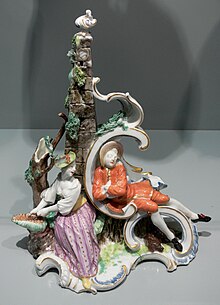
Back Porselein Afrikaans خزف صيني Arabic Porzolana AST Çini Azerbaijani Фарфор Byelorussian Парцаляна BE-X-OLD Порцелан Bulgarian চীনামাটি Bengali/Bangla Porcelan BS Porcellana Catalan



| Porcelain | |||||||||||||||||||||||
|---|---|---|---|---|---|---|---|---|---|---|---|---|---|---|---|---|---|---|---|---|---|---|---|
| Chinese | 瓷 | ||||||||||||||||||||||
| |||||||||||||||||||||||
Porcelain (/ˈpɔːrs(ə)lɪn/) is a ceramic material made by heating raw materials, generally including kaolinite, in a kiln to temperatures between 1,200 and 1,400 °C (2,200 and 2,600 °F). The greater strength and translucence of porcelain, relative to other types of pottery, arise mainly from vitrification and the formation of the mineral mullite within the body at these high temperatures. End applications include tableware, decorative ware such as figurines, and products in technology and industry such as electrical insulators and laboratory ware.
The manufacturing process used for porcelain is similar to that used for earthenware and stoneware, the two other main types of pottery, although it can be more challenging to produce. It has usually been regarded as the most prestigious type of pottery due to its delicacy, strength, and high degree of whiteness. It is frequently both glazed and decorated.
Though definitions vary, porcelain can be divided into three main categories: hard-paste, soft-paste, and bone china. The categories differ in the composition of the body and the firing conditions.
Porcelain slowly evolved in China and was finally achieved (depending on the definition used) at some point about 2,000 to 1,200 years ago. It slowly spread to other East Asian countries, then to Europe, and eventually to the rest of the world. The European name, porcelain in English, comes from the old Italian porcellana (cowrie shell) because of its resemblance to the surface of the shell.[1] Porcelain is also referred to as china or fine china in some English-speaking countries, as it was first seen in imports from China during the 17th century.[2] Properties associated with porcelain include low permeability and elasticity; considerable strength, hardness, whiteness, translucency, and resonance; and a high resistance to corrosive chemicals and thermal shock.


Porcelain has been described as being "completely vitrified, hard, impermeable (even before glazing), white or artificially coloured, translucent (except when of considerable thickness), and resonant".[3] However, the term "porcelain" lacks a universal definition and has "been applied in an unsystematic fashion to substances of diverse kinds that have only certain surface-qualities in common".[4]
Traditionally, East Asia only classifies pottery into low-fired wares (earthenware) and high-fired wares (often translated as porcelain), the latter also including what Europeans call "stoneware", which is high-fired but not generally white or translucent. Terms such as "proto-porcelain", "porcellaneous", or "near-porcelain" may be used in cases where the ceramic body approaches whiteness and translucency.[5]
In 2021, the global market for porcelain tableware was estimated to be worth US$22.1 billion.[6]
- ^ "Porcelain, n. and adj". Oxford English Dictionary. Retrieved 18 Jun 2018.
- ^ OED, "China"; An Introduction to Pottery. 2nd edition. Rado P. Institute of Ceramic / Pergamon Press. 1988. Usage of "china" in this sense is inconsistent, & it may be used of other types of ceramics also.
- ^ Harmonized commodity description and coding system: explanatory notes, Volume 3, 1986, Customs Co-operation Council, U.S. Customs Service, U.S. Department of the Treasury
- ^ Definition in The Combined Nomenclature of the European Communities defines, Burton, 1906
- ^ Valenstein, S. (1998). A handbook of Chinese ceramics Archived September 9, 2016, at the Wayback Machine, pp. 22, 59-60, 72, Metropolitan Museum of Art, New York. ISBN 9780870995149
- ^ 'Porcelain Tableware Market - Outlook To 2031'. Transparency Market Research, 2021.